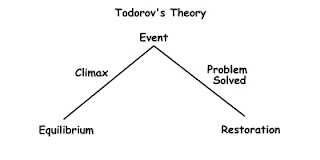There are three different moments which define a narrative. These are:
1) Equilibrium- Start of the film where everything is calm to start with, everyone is most likely to be happy.
2) Disruption- Middle of the film where there is a disruption to the calm, everyone is more likely to be sad.
4)In the process of solving problem- Near the end when everyone resolves the disruption.
3) Return to equilibrium- this is where the problem is resolved and returns back to a calm mood( the equilibrium).
This keeps the audience hooked and interested in the film, this theory is mostly seen in all movies as it is a safe plot to follow.
Usually in a thriller movie by the end the antagonist should be killed there fore following the structure of Todorov's theory. However this does not apply to all thriller films. some have a twist and start from the ending and finishing with the beginning, such as the film 'Cloverfield'. these films rewrite Todorovs theory
1) Equilibrium- Start of the film where everything is calm to start with, everyone is most likely to be happy.
2) Disruption- Middle of the film where there is a disruption to the calm, everyone is more likely to be sad.
4)In the process of solving problem- Near the end when everyone resolves the disruption.
3) Return to equilibrium- this is where the problem is resolved and returns back to a calm mood( the equilibrium).
This keeps the audience hooked and interested in the film, this theory is mostly seen in all movies as it is a safe plot to follow.
Usually in a thriller movie by the end the antagonist should be killed there fore following the structure of Todorov's theory. However this does not apply to all thriller films. some have a twist and start from the ending and finishing with the beginning, such as the film 'Cloverfield'. these films rewrite Todorovs theory

No comments:
Post a Comment